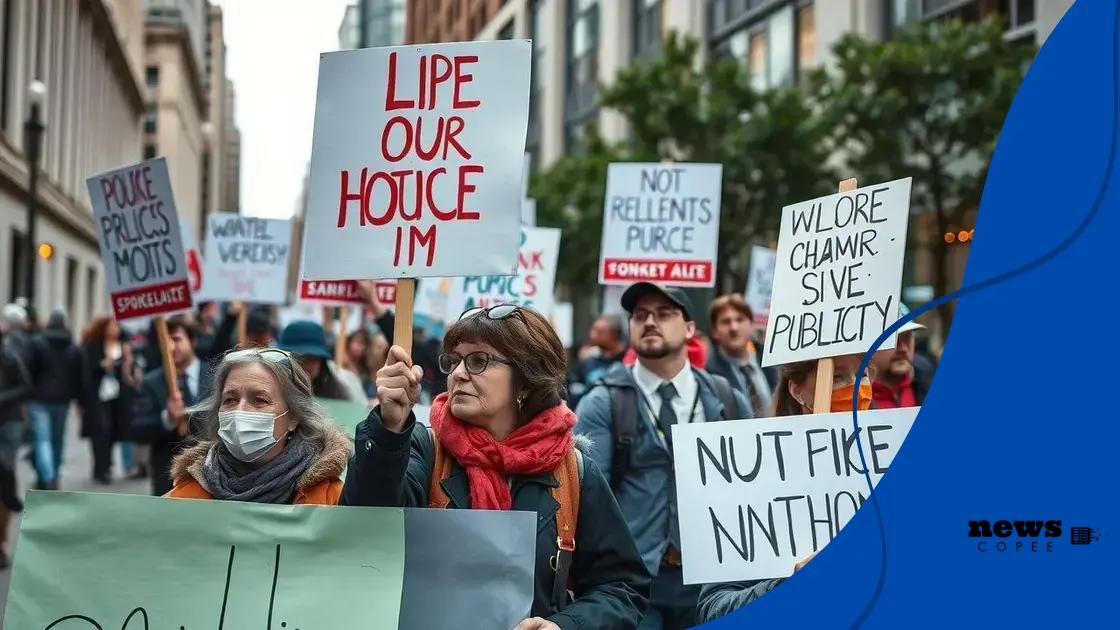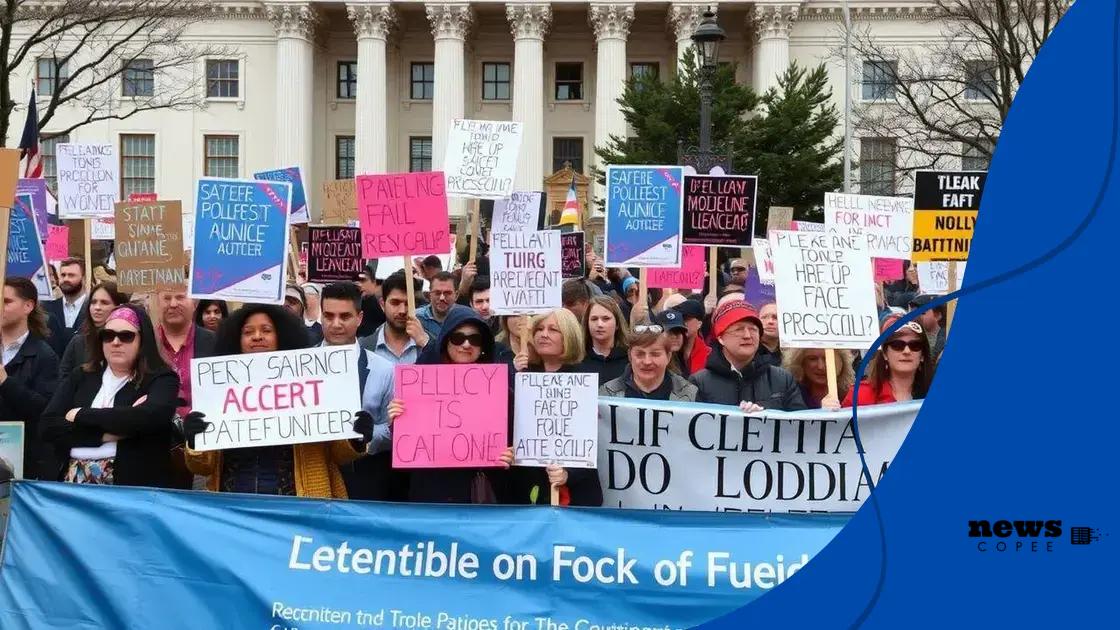Public employee protests covered: insights and developments

Public employee protests are organized actions by workers in the public sector advocating for better wages, working conditions, and policies, effectively driving significant changes in public policy and community support.
Public employee protests covered bring to light critical issues affecting workers and the public at large. It’s fascinating to see how these movements shape our society, isn’t it? Let’s dive into the details.
Current trends in public employee protests
Understanding the current trends in public employee protests gives us a glimpse into the evolving landscape of labor rights. As society changes, so do the needs and demands of public employees. This shift is crucial, affecting everything from policy changes to public opinion.
Key Factors Influencing Protests
In recent years, several factors have driven public employees to organize and protest. These factors include:
- Inadequate pay and benefits
- Working conditions and employee rights
- Political decisions affecting public services
Each of these issues not only influences individual employees but also shapes the public sector landscape as a whole. With growing tension, it’s clear that these protests serve a broader purpose.
Importance of Solidarity
Solidarity among public employees is becoming increasingly vital. Unions and advocacy groups play a crucial role in this solidarity. They help to unify voices and create a larger impact. When public workers come together, they can:
- Effectively communicate their concerns
- Organize major events and protests
- Influence legislation and policy
The impact of strong solidarity can be seen in various movements across the country. It’s an essential aspect of how public employees advocate for themselves.
Moreover, the media’s role in highlighting these protests cannot be overlooked. Coverage of the protests not only educates the public but also puts pressure on policymakers to address the issues at hand. As more people become aware of the challenges faced by public employees, public support often grows, leading to more substantial changes.
In essence, current trends in public employee protests illustrate the ongoing struggle for fairness and better working conditions. Highlighting these aspects enables a broader understanding of the issues at play in our society.
Key issues driving the protests
In recent times, various key issues driving the protests have emerged. These issues reflect the concerns and frustrations of public employees across different sectors. Understanding these factors is essential to grasp the significance of the protests.
Economic Concerns
One of the most pressing issues is economic insecurity. Many public employees face stagnant wages that do not keep pace with the cost of living. As a result, they struggle to make ends meet. This situation has spurred many to take action.
- Increased living costs
- Stagnant salaries
- Underfunded public services
These challenges highlight the economic pressures that force employees into the streets to demand better conditions.
Workplace Conditions
Another significant factor is the need for improved workplace conditions. Many public sector employees report high levels of stress due to heavy workloads and inadequate support. This can lead to burnout and decreased job satisfaction. When employees feel unsupported, their motivation dwindles, prompting them to protest for change.
Issues like lack of resources and insufficient staffing also contribute to this sense of urgency. Employees are calling for:
- Better training and support
- More staffing to meet demands
- Safer working environments
These aspects are critical for ensuring not only the well-being of the employees but also the effectiveness of the public services they provide.
Political factors further complicate the situation. Decisions made at various government levels can have significant implications for public employees. Protests often arise in response to policies perceived as unjust or harmful, motivating workers to stand up for their rights.
As these key issues become increasingly prevalent, the protests continue to grow, signifying a demand for urgent change within the public sector. This dynamic demonstrates how interconnected various factors can be when it comes to public employee activism.
Impact of protests on public policy

The impact of protests on public policy is significant. When public employees take to the streets, their voices often lead to changes that can reshape laws and regulations. Understanding this impact is essential to appreciate the role of activism in our society.
Shaping Legislative Change
Public protests often highlight critical issues that need attention. Lawmakers and decision-makers cannot ignore the concerns of the workforce. Therefore, when large groups advocate for change, it can lead to the introduction of new legislation or amendments to existing laws.
- Increased funding for public services
- Improved labor rights and protections
- Establishment of task forces to address specific issues
These changes usually stem from the pressure that well-organized protests put on policymakers. The louder the collective voice, the more likely it is that officials will listen.
Influence on Public Opinion
Protests also have a profound effect on public opinion. As the community becomes aware of the struggles faced by public employees, support often grows. Media coverage and social media play a vital role in disseminating information quickly.
When citizens see public employees advocating for their rights, it can shift perceptions about issues such as worker compensation, job security, and funding for essential services. This growing awareness can create a ripple effect, encouraging more people to get involved.
Moreover, increased public support can lead to more significant political action. Lawmakers may feel compelled to act when they see growing public interest and concern, resulting in a more responsive government.
In essence, the impact of protests on public policy can be profound, driving legislative reforms and shaping public perceptions. This dynamic is essential for fostering a responsive and effective governance system.
Case studies of recent protests
Examining case studies of recent protests provides insight into how public employee movements can drive change. These examples demonstrate the power of collective action and its effects on policies and public awareness.
Case Study 1: Teachers’ Strike
In 2018, teachers in several states, including West Virginia and Oklahoma, organized strikes to demand better pay and school funding. The strikes garnered national attention and highlighted the struggles faced by educators.
- Teachers rallied for salary increases.
- They demanded better classroom resources.
- The movement inspired solidarity across the country.
This series of protests ultimately led to increased funding for education in several states, showcasing the influence of grassroots movements.
Case Study 2: Healthcare Workers’ Advocacy
In response to the COVID-19 pandemic, healthcare workers across the U.S. staged protests for better working conditions and safety measures. They faced long hours and insufficient protective equipment.
- Workers voiced concerns about safety protocols.
- The protests raised awareness about mental health issues within the healthcare profession.
- Many hospitals updated their safety regulations following these demonstrations.
This case highlights how urgent circumstances can lead to powerful advocacy efforts that prompt immediate change.
Each of these case studies illustrates the significant impact that organized protests can have on policy and societal attitudes. The actions of public employees not only demand immediate changes but also pave the way for long-term improvement in their respective fields. When voices unite, they create a force that cannot be ignored, demonstrating the importance of solidarity and activism in initiating reforms.
Future of labor movements and public employees
The future of labor movements and public employees appears to be evolving as new challenges and opportunities arise. As the workforce changes, so do the strategies employed by public employees to advocate for their rights and needs.
Emerging Trends
One significant trend is the increasing use of technology in organizing and mobilizing protests. Social media platforms enable workers to connect, share information, and coordinate actions more efficiently than ever before.
- Online campaigns to raise awareness
- Virtual meetings for organizing
- Hashtags to unify voices and messages
This technological shift allows groups to reach broader audiences and generate support quickly, making it easier to influence public opinion and policy.
Focus on Inclusivity
Another key aspect shaping the future is the focus on inclusivity within movements. Public employee protests are increasingly emphasizing the importance of representing diverse voices. This means advocating not just for wages and benefits but also for issues related to equity, diversity, and inclusion.
When labor movements broaden their scope, they can unite various groups, such as educators, healthcare workers, and civil servants, creating a stronger collective force. This approach highlights issues faced by marginalized workers, amplifying their concerns in the broader labor discourse.
Moreover, as younger generations enter the workforce, they bring new perspectives and priorities. They often prioritize work-life balance, mental health support, and flexible working conditions. Labor movements must adapt to these evolving expectations to remain relevant and effective partners in advocacy.
In summary, the future of labor movements is poised for transformation. By leveraging technology, promoting inclusivity, and responding to the changing needs of employees, public labor movements can continue to thrive and effect meaningful change in society.
FAQ – Frequently Asked Questions about Public Employee Protests
What are public employee protests?
Public employee protests are actions taken by workers in the public sector to advocate for better working conditions, pay, and policies.
How do protests impact public policy?
Protests can lead to legislative changes by drawing attention to workers’ issues, influencing public opinion, and prompting policymakers to take action.
What role does technology play in organizing protests?
Technology, especially social media, allows workers to connect, share information, and mobilize more effectively for protests.
Why is inclusivity important in labor movements?
Inclusivity helps ensure that diverse voices are represented, strengthening movements and addressing a broader range of issues faced by workers.
